Identifying snakes in Queensland can be a challenging prospect for those who aren’t used to seeing snakes. If you’re scared of snakes, then all snakes can look dangerous, but the vast majority of them aren’t venomous and most won’t harm you unless threatened. But if a snake does enter your home or garden, it might be a good idea to be able to identify them so that when you call a snake catcher, you can tell them what species it is.
In this article, we offer a comprehensive QLD snake identification list for you.
Eastern Brown Snake (Pseudonaja textilis)
A slender snake that is highly venomous and potentially dangerous, especially when it feels threatened or cornered. The snake is very long, growing to about two metres. Normally their distinctive pale brown or grey colour is enough to identify adults, but younger Easter Brown snakes can be confused with the more colourful tiger snakes.
These snakes prefer to live in grasslands and woodlands. But they have, especially in recent years, been known to enter urban areas, especially gardens, sheds, and homes. Their favourite prey includes rodents, birds, frogs, and reptiles, which are often close to human habitation.

Image: Stephen Mahony © Australian Museum
Red-Bellied Black Snake (Pseudechis porphyriacus)
Another venomous snake from the area, the red-bellied black snake will grow to about 1.5 metres in length. Compared to other venomous snakes in the area, the venom from this species is relatively mild, but the snake can still pose a risk and so should be left alone.
They prefer prey that can often be found near bodies of water like frogs and other reptiles. Therefore, they tend not to enter urban areas unless there is a pond, lake, or swimming pool in the home.
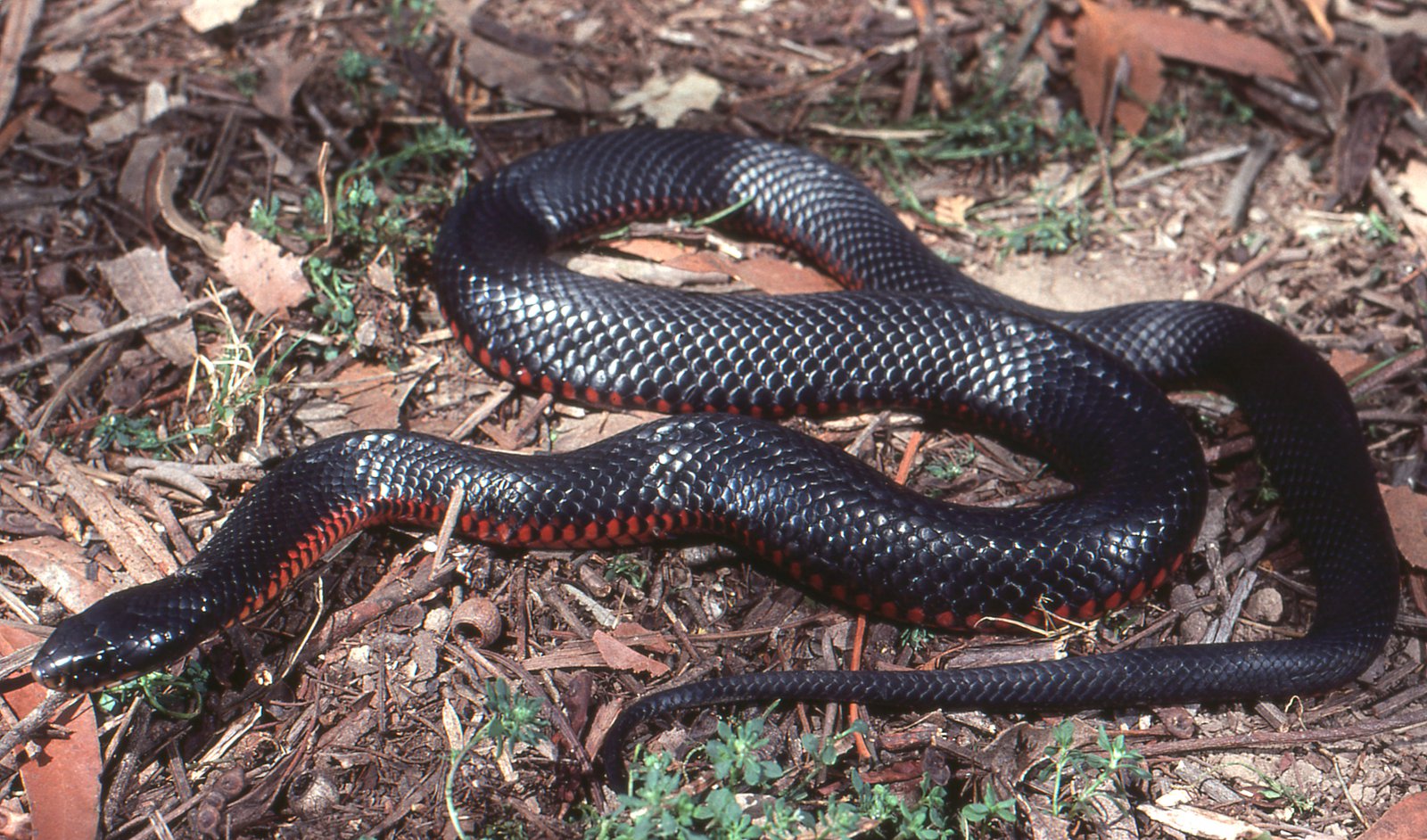
Image: D & V Blagden © Australian Museum
Brown Tree Snake (Boiga irregularis)
The brown tree snake is widely distributed, often along the coast of Australia. They are relatively long, reaching lengths of about 200 cm. They are nocturnal species of snake which are rear-fanged. Rear-fanged species are venomous but tend to offer a less potent venom. Most adults who are bitten will be fine, although young children and those with poor immune systems can often have issues.
This species is known to prefer birds, hence they spend most of their time in trees. Though they will eat rodents and bats at times.

Image: © Pavel Kirillov
Green Tree Snake (Dendrelaphis punctulatus)
This is an easily recognised species of non-venomous snake. It has a slender body and tail, giving it a unique appearance in the trees. Its colours can vary from a golden yellow to a bright green/olive-green dorsal body. The species often sports a pale yellow throat and underside.
The species is found in a wide range of habitats, from woodlands to urban areas, where it finds its favourite prey such as fish, frogs, and other small animals. Unlike other snakes, it doesn’t rely on venom or constriction, rather just overpowering their prey and swallowing them alive.

Image: © Charles J. Sharp
Carpet python (Morelia spilota)
The carpet python, otherwise known as the diamond python is a stunning snake that is often kept as a pet across the world. They’re arboreal snakes that can reach an impressive length of 2 metres. You will often find them in trees, rock ledges, or on roofs, which often makes them challenging to relocate for snake catchers.
However, they’re known to also use hollow logs and rodent burrows for homes. This species is non-venomous and non-threatening to humans if left alone. They tend to eat marsupials, possums are a particular favourite, though they will sometimes eat reptiles and rodents.

Image: © Adam Brice
Death Adder (Acanthophis antarcticus)
One of the most dangerous snakes in Australia, the common death adder, or death adder for short, is a highly venomous snake that reaches lengths of just 60 cm on average, though some individuals have been measured at a metre. The snake is highly dangerous because of its hunting technique. It is a camouflage expert, hiding in long grass or other undergrowth for prey to walk past. But if disturbed, it can bite as a defence.
Death adders are very dangerous and need to be respected at all times. Never approach a death adder and always call an expert to remove it.
The biggest threat to death adders is the cane toad. Young death adders are eaten by this invasive species.

Image: © Melissa Bruton
Blue-bellied black snake (Pseudechis guttatus)
Also known as the spotted black snake, this is a venomous snake that is native to Australia and found in south-eastern Queensland. They prefer to live in grassland areas, shrubland, and savannas but have also been known to be found in urban areas. They are a relatively shorter species than some of the others on the list, growing to about 120 to 150 cm.
Its colours range from black to dark grey with white/cream spots. It can also be a relatively light colour, depending on the individual. The belly of the snake is either blue or blue-grey.
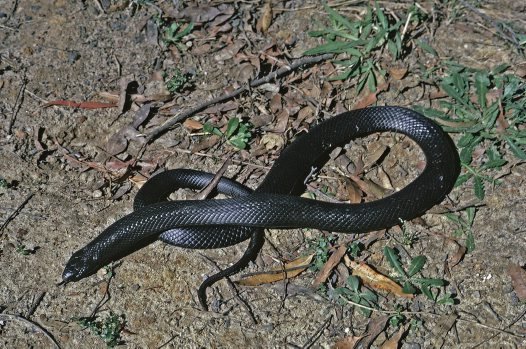
Image: © Hal Coggar
Spotted python (Antaresia maculosa)
Otherwise known as the Eastern Children’s Python, it is a popular pet snake in Australia and across the world. They are a non-venomous species that prefer to eat bats, and so are often found near caves where they climb the walls and hang off the top of the cave.

Image: © dhfischer
Small Eyed Snake (Cryptophis nigrescens)
With a range of common names, this venomous snake species can be found across Eastern Australia. It is a small, nocturnal species with a slightly flattened head that is barely distinct from the body. The blue-black body is strikingly attractive. Though their underside can vary in colour from cream to a bright coral pink.
They are found in high-moisture environments such as rainforests. They will hide during the day underneath a wide variety of objects including fallen timber and stones.

Image: © Reiner Richter
Rough-scaled snake (Tropidechis carinatus)
This highly venomous snake is olive to greyish colour with black flecks that form irregular bands/blotches. The underside is greenish-grey. Their name is derived from the raised lines or keels on the body scales that cover their backs/sides.
The snake is often confused with the keelback, which has a similar set of keeled scales. Both snakes are also found in the same area and near water.
The snake can grow to 1 metre and will eat a wide range of prey from small mammals to amphibians.
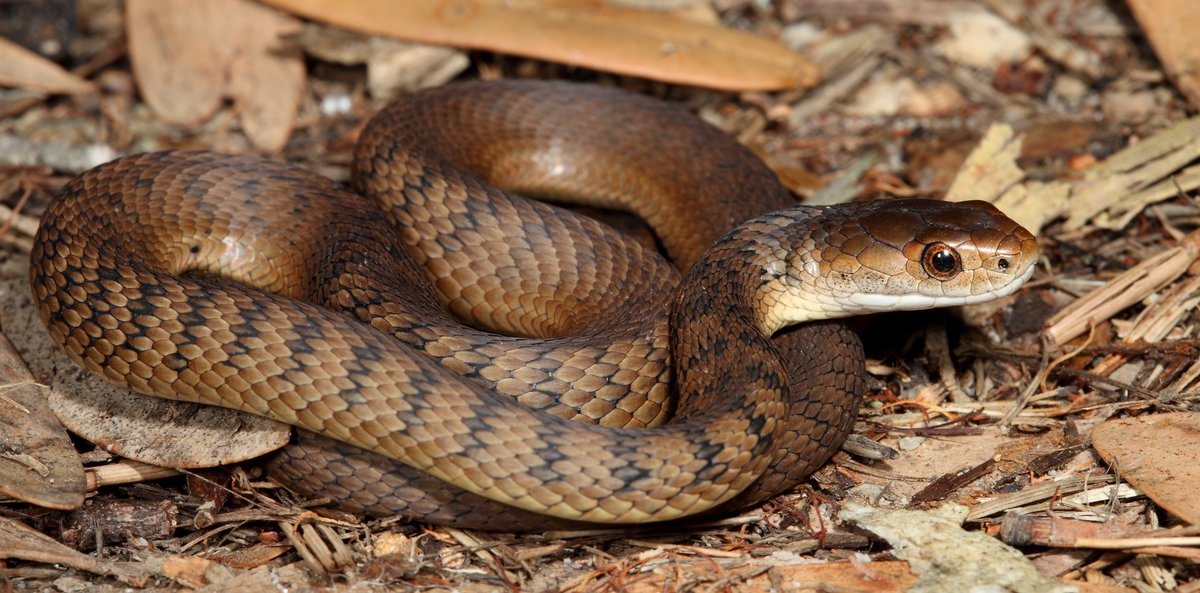
Image: © Stephen Mahony
Yellow-faced whipsnake (Demansia psammophis)
This slender, fast-moving species is a diurnal species (out during the day). It is very common throughout Australia and often confused with the Eastern Brown snake, but it is hard for those not used to snakes to observe closely because they often flee when humans approach.
The snake is pale grey or brown, usually with a reddish colouring on the head. Sometimes they might have a tint of red on their tail. A dark comma shape can be observed from the eye to the corner of the mouth. Sometimes the face will be yellow, and they will also have a yellow-edged bar that goes between their nostrils.
They are a relatively small species, reaching lengths of just 80cm.

Image: © Stephen Mahony
Bandy Bandy (Vermicella annulata)
This small snake, which reaches lengths that rarely exceed 60cm, is harmless. They tend to be black and white stripes. The snake is a nocturnal hunter of blind snakes and is capable of eating meals that are larger than itself.
You will rarely see this snake, but if you do, you might see that its last meal is hanging out of its mouth.

Image: © Ken Griffiths
Chequered keelback (Fowlea piscator)
Also known as the Asiatic water snake, this is a fairly common non-venomous species to come across. It is also widely distributed, being found across Asia and Australia.
The species has a relatively small eye. Colouration of the species can vary, with many dark spots, separated by a whitish network. Alternatively, it might have black bands on a pale background.
The snake is relatively large, growing to nearly 175 cm.

Image: © Jonathan Hakim
Stephens's banded snake (Hoplocephalus stephensii)
This species has a relatively broad head compared to the neck and the body is coloured with pale grey/yellow bands on a background of rusty brown or black. Their underside is usually cream, but can sometimes be grey with dark edges.
This venomous species grows to a maximum of 120 cm, though it is more common to be 90cm.

Image: © Bernard Dupont
Coral Snake (Brachyurophis australis)
This species has numerous common names, including easter shovel-nosed snake, coral snake, and Australian coral snake. The snake is relatively small, with a maximum size of 45cm. The snake is often coloured pink or orange. It has two dark bands, one of these is across the head, and the other is across the nape of the individual.
The underside of these snakes is cream. As one of its common names suggests, the nose of this species is upturned and blunt.

Image: © dhfischer
Green Tree Python (Morelia viridis)
This python species is native to many Indonesian islands, but it can also be found in some parts of Australia. It is a bright green snake that can be up to 200 cm long. The snake is non-venomous, feeding on a variety of prey items including birds, reptiles, and mammals.
As the name suggests, they spend a large amount of time hanging out in trees. Most of the time they are coiled around a single branch not moving. They will hunt at night.

Image: © Daniel Townend
Scrub Python (Simalia amethistina)
This is another Indonesian python that can be found across Northern Australia. They are very popular among exotic keepers because of their attractiveness and size. They are relatively calm as well, being good handlers for those keeping them.
The snake tends to live in bushland or suburban locations. Though they might also be found in rainforests.
They live a solitary nocturnal lifestyle, with young snakes spending most of their time in trees. Adults prefer spending time on the ground. They’re particularly good at swimming as well.

Image: © Carlos N. G. Bocos
Woma Python (Aspidites ramsayi)
The woma python is an endangered species in Australia. It is found in many different habitats such as deserts, shrublands, and even in urban areas if there is prey there. They prefer environments with sandy soil.
They’re secretive snakes, during the day they will hide in a burrow that could be in the ground or a hollow low.
At night they hunt, chasing prey down into burrows. When cornered, they will pin their prey against the wall of the burrow to kill them.

Image: © Tom Hunt
Mulga Snake (Pseudechis australis)
The mulga snake is long, growing to lengths that can be 250 cm. Females tend to be on the smaller side. Their head is often very broad, and they also have rounded snouts.
The mulga snake is a venomous species but it is often not found in urban areas. They prefer to live in damp tropical forests or dry sand deserts. They hunt other snakes, often at dusk.
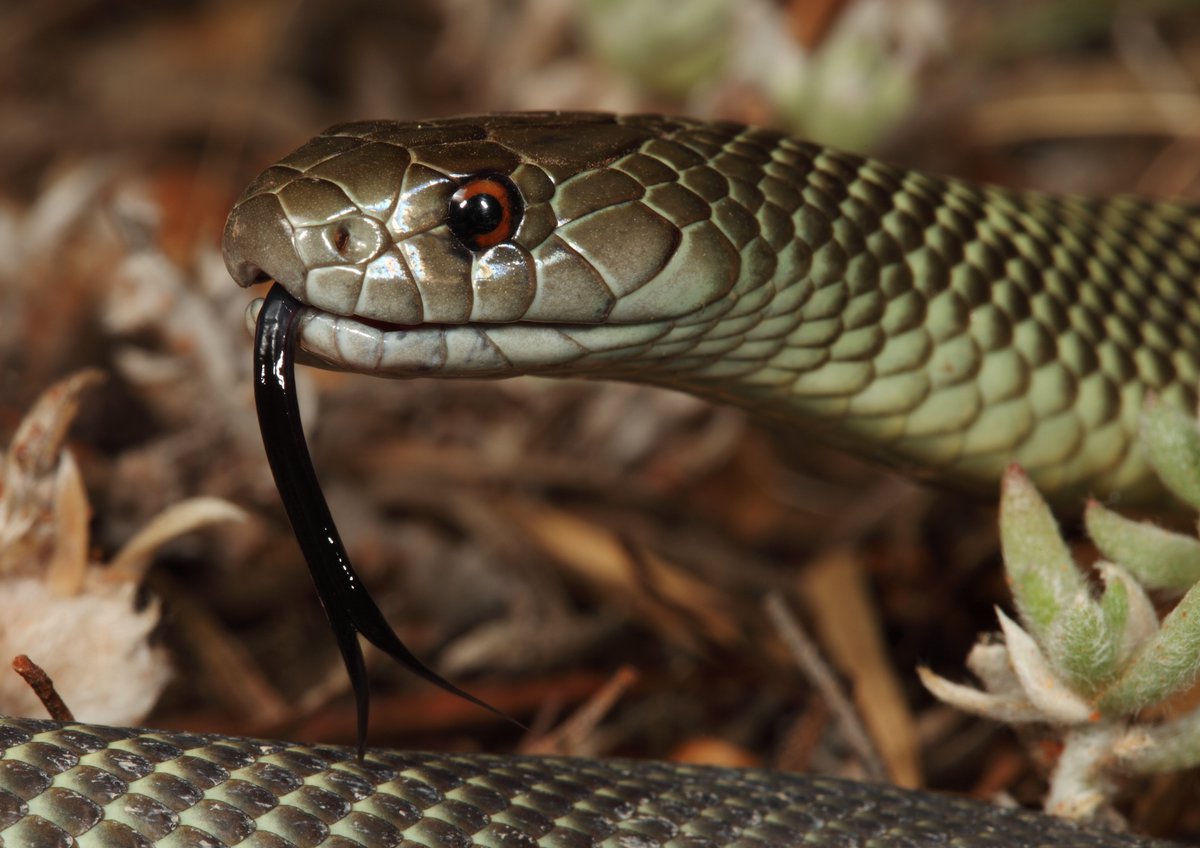
Image: © Stephen Mahony
Taipans
There are three different taipans that you might come across, these are the Inland, Coastal, and Western Desert. These snakes can reach lengths of up to two metres. In Queensland, you’re more likely to come across the Inland taipan.
They’re an aggressive set of snakes, venomous and highly dangerous. Therefore, you should stay away from them.
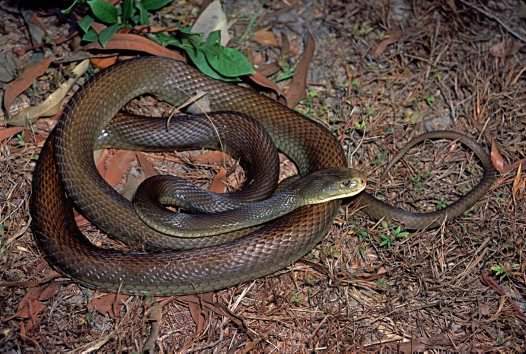
Image: © Hal Coggar
Final Word: Snakes: Queensland Identification
Above are most of the snakes that you will find in Queensland. There is a wide diversity of snakes in the Australian state and many of them are naturally very beautiful. However, if you’re not a snake expert, it is best if you don’t get too close. If you don’t know whether a snake is venomous or dangerous, that is when you’re most at risk.
If you do see a snake in your home or garden, it is best to contact a local snake catcher and get them to remove it. If you can take a picture or identify the snake, then you can make it a safer job for the snake catcher. Otherwise, try to remember the size, colour, and pattern of the snake, as this can help identify the snake. For good measure, we recommend installing non-toxic snake deterrent devices to prevent snakes from invading your property.
FAQ about Snakes in Queensland
When are snakes most active in Queensland?
Snakes are most active between September and February in Queensland. This is when they are seeking prey and breeding partners. It is also when their prey is most active.
Do snakes hibernate in Queensland?
In Queensland, snakes hibernate or brumate (depending on your definition). This is when snakes retreat to their winter dens and are less active.
What types of snakes are in north Queensland?
Over 40 types of snakes, including venomous species and pythons, are found in the tropical regions of North Queensland.
What types of snakes are in southeast Queensland?
There are numerous species of snake in southeast Queensland, but the most commonly found include the carpet python, common tree snake, and keelback.
When is snake season in Queensland?
Snake season is between September and February. This is when the snake’s prey is most active, and it is a good season for breeding. During the winter months, most snakes will brumate/hibernate.












